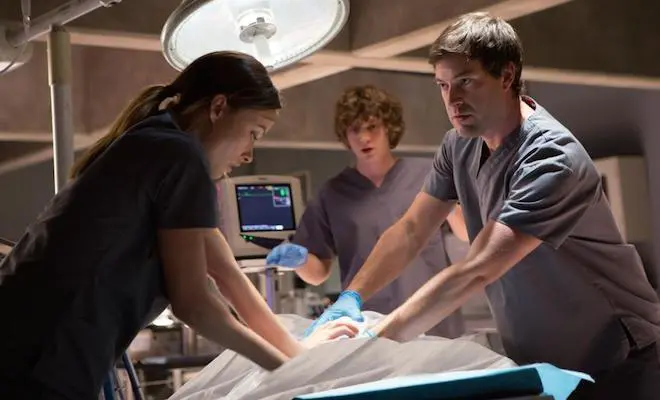The power to beat death is something that humans have sought since the beginning of time. And it’s been used as a vehicle for fiction for nearly just as long. Seriously, there are cave paintings depicting hunters surviving near-death experiences. When handled well, as in Mary Shelley’s Frankenstein, the results are gold. When handled badly, we are left with The Lazarus Effect.
The Lazarus Effect is a short, sometimes silly thriller that dies before it even gets going. It has some good ideas, but instead of exploring them, it relies on silly “shock” scares, complete with inexplicable on-film screams for effect. When it tries to tell the story, it’s hampered by miscasting in the male lead (Indie-darling Mark Duplass, who just can’t sell obsessed “scientist”), and the rest of the cast is rounded out by TV stars looking for paychecks, like Evan Peters (yes, I know he was Quicksilver in X-Men: Days of Future Past, but before that he was on American Horror Story), Sarah Bolger (ABC’s Once Upon a Time) and Olivia Wilde, who carries the film as best she can.
The story of The Lazarus Effect revolves around a team of researchers who stumble upon a scientific way to bring things back to life. After a few “shock” scares involving animals “suddenly” coming back to life, Frank (Duplass) and Zoe (Wilde) decide to take one of the newly reanimated pets home, but something isn’t right. Things happen and Zoe ends up dying, forcing the team to debate for about thirteen seconds whether they should or shouldn’t use the technology they barely understand to reanimate her as well. This is when the pace of the film completely goes haywire and things go off track.
An example of this is a subplot involving Ray Wise showing up to take all of the team’s data and research due to a hastily explained contract breech and then we never hear or see of Wise again. The script by Luke Dawson and Jeremy Slater hints of academic/corporate espionage and a traitor in the team, but it’s never revisited. And this is the biggest problem with The Lazarus Effect.
The script dances around some interesting elements, but then abandons them for silliness and familiar themes, and by the time the film starts dipping its toe in the interesting part of the pool late in the third act, it’s over. Have I mentioned that The Lazarus Effect is only 83 minutes long — with credits? It’s not like there wasn’t time to flesh out these ideas and actually shoot for something unique. Instead, we get insipid performances, shock jumps out of reanimated animals, and formulaic horror where everyone dies, with the black guy (Donald Glover) going first, because, well, it’s an unwritten rule in bad horror films, apparently.
One big miss is how The Lazarus Effect tickles the concept of heaven and hell, but instead of trying to present a compelling argument, Wilde’s Zoe turns into horror’s version of Lucy (Scarlett Johansson’s 2014 film).
The PG-13 rating keeps The Lazarus Effect from offering any gore or nudity, and again, the scares are so few and far between, and ridiculously over the top that one lady in my audience laughed out loud for about five minutes. That was five minutes of this 83-minute film where at least she was having a good time. This was a missed opportunity and unlike Zoe, it can’t be brought back from the dead.
The Lazarus Effect is PG-13 and is in theaters nationwide.





